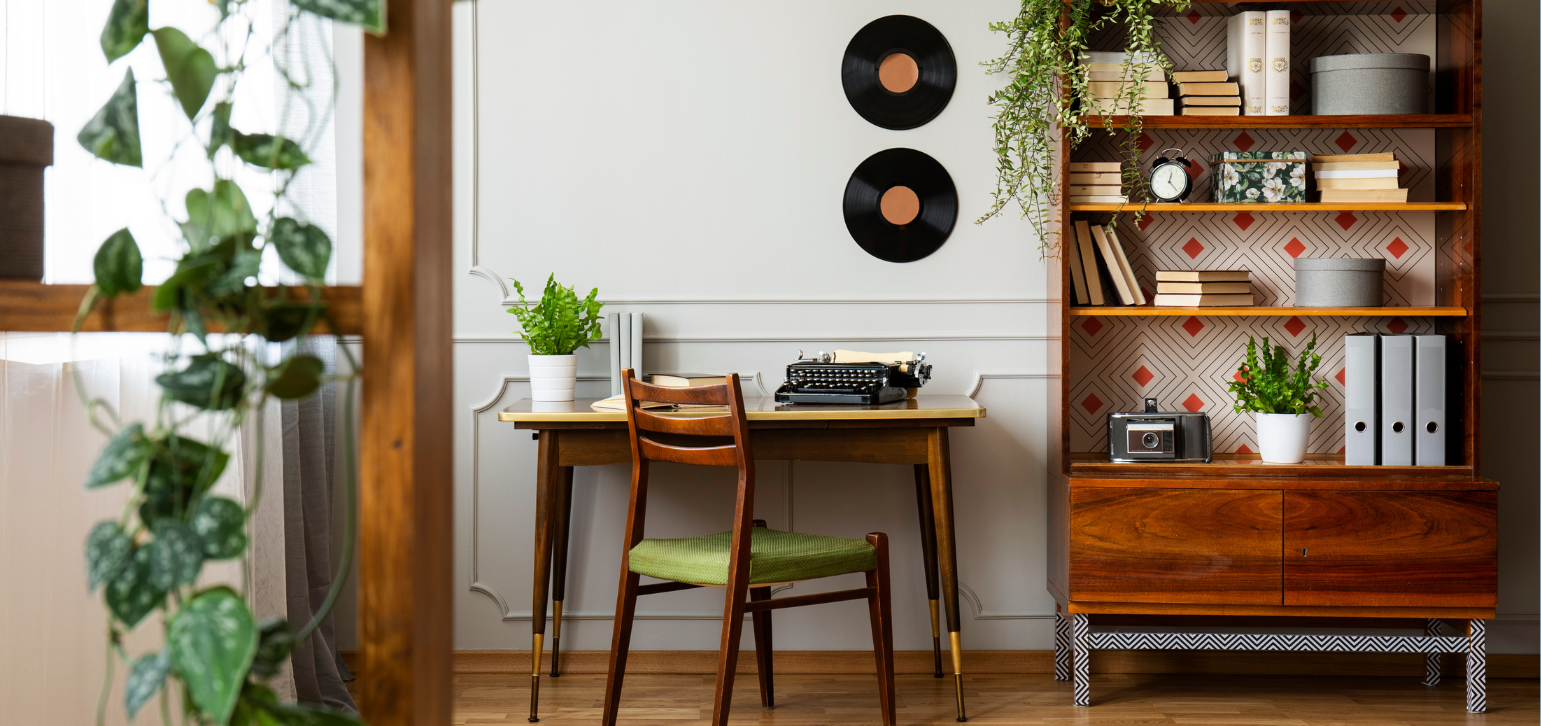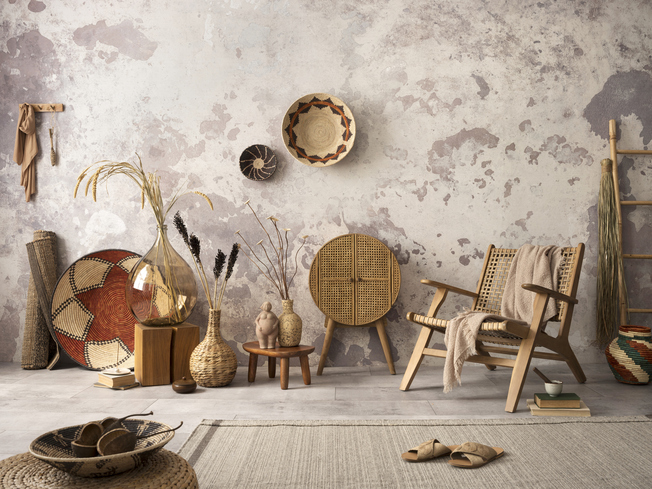
Midcentury Modern Interior Design: Everything You Need to Know
Mar 15, 2024
To dive into the world of midcentury modern interior design is to behold an impressively long (and ongoing) history — and a fascinating evolution throughout the 20th century. Midcentury modern (sometimes shortened to MCM) refers to furnishings that originally came from the 1940s all the way through the 1970s, complementing architecture of the same era (picture Frank Lloyd Wright) that featured floor-to-ceiling windows, long and clean lines, and put nature on display both outside and inside with stunning hardwoods like teak and oak.
Midcentury modern’s first big resurgence happened in the 90s, when designers like Herman Miller popularized iconic midcentury fixtures such as the Noguchi table, the Nelson Saucer Bubble light, and the Eames lounge chair. A decade later in the 2000s. “Mad Men,” with its textbook midcentury set design, took households by storm, influencing our tastes as television often does.
Midcentury modern interior design still stands the test of time, remaining central to modern consumers’ tastes since its 90s resurgence. Today, for example, the Eames chair is selling more successfully than it ever has, according to the Washington Post. But lately, there are infinite ways to revisit this sophisticated style in renter-friendly ways, no matter if you adhere to the original looks or make it entirely your own. The bottom line: The sleek lines of the MCM style are here to stay.
Aesthetic Origins
The idea with midcentury modern décor and architecture when it first became popular in the 1940s was to marry indoor and outdoor living. After World War II, American households were ready to make a return to nature after the minimalism and geometric machine-era looks of the preceding Art Deco and Bauhaus eras. Plus, when the Great Depression hit in the 1930s, the Roaring Twenties’ aesthetics of excess turned on its head and became affordability focused. Midcentury modern furnishings fit the bill, so to speak, since they were affordable at the time.
But besides culturally driven reasons for midcentury modern’s high initial impact, the fresh furniture design was fundamentally new and different compared to home decor from eras past. Simply put, people were refreshed and intrigued: The interior design style put a new meaning to multi-media, emphasizing not only outdoor views, plants, and natural materials but also on glass-top tables and avant-garde chandeliers. (This is the primary difference between MCM style hailing from America and the popular Scandinavian design style of the same era; the latter focuses much more strictly on natural rather than new materials.) Midcentury modern looks also made statements in pieces like large, clean-lined walnut credenzas for entryways and funky chairs made out of organic shapes for, well, any room in the home.
Mid-century furniture emphasized subtlety and large geometric shapes (as opposed to the more detailed, geometric patterns that predated them). Mid-century style was cozy yet grand, marrying practicality and ease of personalization — qualities that ultimately gave it inertia throughout history.
Contemporary Applications
The midcentury modern style has some of the most impressive staying power of any interior design genre due to its emphasis on quality craftsmanship, sophisticated-yet-creative vibe, and ease of access for today’s consumers. It’s evolved since its original applications in the 1940s and its resurgence in the 1990s, dividing into further subgenres: Vibrantly colorful midcentury homes are taking over design TikTok, and celebrity home tours like Dakota Johnson’s are wowing viewers. But whether a person’s taste leads them toward the candy-coated or the Hitchcockian version of the style, today’s strategies still lean in a few consistent directions.
Yesterday’s furniture is today’s dream. Lately, midcentury modern design for renters relies in part on found furniture and other items because brand-new items tend to come with a hefty price tag due to high demand. Armchair (and professional) interior designers in search of the perfect midcentury modern pieces have been riding the thrifting wave, one of only ways to go “back in time” to look for authentic midcentury elements that suit your space. If you’re lucky, you might also have older relatives or neighbors who are looking to refresh their spaces and give away their original midcentury finds. Free furniture? Yes, please.
Fresh furniture still counts. The premium on new furniture that falls within the midcentury genre is not one every renter wants to go up against, but it can be worth it to invest in a staple — and a design focal point — like a stunning dresser or statement chairs with that unmistakable midcentury look: a gravity-defying frame, sandy wicker laced across the back, and a comfortable, colorful cushion. Since the genre has remained relevant since its inception almost 100 years ago, you can rest assured your brand new coffee table, for example, will follow suit and stay fresh.
Achieving the Look in Your Apartment
Renters might feel intimidated by the concept of midcentury modern design because of its heavy reliance on built-in wood features, natural light, and large furniture. But you don’t have to be living in a Frank Lloyd Wright home to achieve the style. Here are some decorating ideas that can help you bring the hallmarks of the mid-20th century into your apartment.
Fabric is your friend. It can be difficult to find midcentury modern furniture because it’s in such high demand — and even if you found that perfect dresser, table, chair, or bed frame, tying in midcentury prints like concentric circles and groovy waves, and materials can help bring the look together. If you’re looking to vary your textures and materials, reach for earthy and moody toned velvet (Think: dark oranges, blues, and greens) when you’re considering fun elements like pillows and colored upholstery in your midcentury modern living room.
Don’t neglect the color scheme. Although midcentury modern design is flexible when it comes to colors, it can help to develop color schemes for each room and stick (mostly) with them. That way, each room at large will make sense, and the midcentury elements can be allowed to shine through more freely. Plus, having a color palette in mind can help you make more intentional consumer decisions that are worth the money. So, in other words, try to plan your pops of color.
Commonly, midcentury modern homes’ color schemes will be based in the tones of the wood built into the home. In your apartment, where you might be working with white-washed walls or brick, it might be easier to start with one statement piece of furniture, like a console table or coffee table, and build out your color scheme based on how that piece inspires you.
When in doubt, go back to basics. When it comes to midcentury modern designs, if you’re unsure or feeling uninspired, remember that the style is based in comfort and a return to simplicity. Add a plant, incorporate more on-theme accents, and revisit your chosen color scheme to discern whether there are colors you need more of.
But part of the beauty of the midcentury modern style is that you can make it your own; a quick Google image search reveals that examples of the style are each very distinct from the last, ranging from minimalist to maximalist, from terrestrial to candy coated, from bohemian leaning to sleek and simple.
Be inspired by famous brands. If you are looking for examples of peak midcentury modern furniture design, check out a few of these famous brands and designers that helped popularize (and re-popularize) the style:
- Knoll
- Eero Saarinen
- Charles and Ray Eames
- Arne Jacobsen
- George Nelson (once lead designer for Herman Miller)
Top cities
Atlanta Apartments
1,975 apartments starting at $600/month
Austin Apartments
4,637 apartments starting at $600/month
Baltimore Apartments
1,383 apartments starting at $595/month
Boston Apartments
3,184 apartments starting at $425/month
Charlotte Apartments
2,920 apartments starting at $450/month
Chicago Apartments
4,493 apartments starting at $450/month
Dallas Apartments
5,337 apartments starting at $627/month
Fort Worth Apartments
2,245 apartments starting at $600/month
Houston Apartments
5,175 apartments starting at $520/month
Las Vegas Apartments
1,105 apartments starting at $695/month
Los Angeles Apartments
11,672 apartments starting at $400/month
Miami Apartments
518 apartments starting at $1,195/month
Milwaukee Apartments
861 apartments starting at $465/month
New York Apartments
4,279 apartments starting at $800/month
Oakland Apartments
620 apartments starting at $750/month
Orlando Apartments
819 apartments starting at $728/month
Philadelphia Apartments
3,276 apartments starting at $500/month
Phoenix Apartments
4,182 apartments starting at $500/month
Pittsburgh Apartments
1,028 apartments starting at $600/month
Portland Apartments
2,408 apartments starting at $649/month
Raleigh Apartments
1,327 apartments starting at $650/month
San Antonio Apartments
3,902 apartments starting at $468/month
San Diego Apartments
2,698 apartments starting at $650/month
San Francisco Apartments
474 apartments starting at $675/month
San Jose Apartments
435 apartments starting at $1,300/month
Seattle Apartments
3,485 apartments starting at $450/month
Tampa Apartments
1,137 apartments starting at $799/month
Washington DC Apartments
2,916 apartments starting at $975/month


